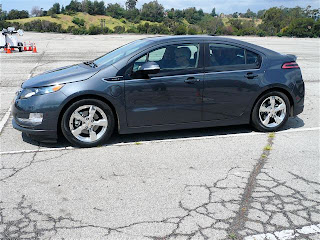This amazing 2-seat enclosed "cabin" electric motorcycle can travel close to ten miles on a kWh of energy while traveling 70 mph on the freeway. That's the equivalent of about 350 miles per gallon!
My buddy, Stefano Paris, drove this amazing vehicle to the beach on Sunday and enticed me aw
 ay from my friends at the rings with the promise of an extended test drive on the LA freeways.
ay from my friends at the rings with the promise of an extended test drive on the LA freeways.This is the view from the cockpit as Stefano arrived at the beach. Stares from eve
 ryone!
ryone!My friend, Alexandra, tried to convince me she should get the ride, but I wasn't about to give up my turn in the E-Tracer for anything!
Stef wanted to drive across town to Pasadena to visit a friend. So, I settled into the back seat, which looked very cramped until I got in and found my legs could stretch out fully making for a very comfortable ride.
The E-Tracer, being an enclosed motorcycle, presents an interesting problem when coming to a stop. Since you can't put your leg down as on a normal motorcycle, you have to flip a lever on the dash which triggers outrigger-style wheels that immediately (within half a second) hit the ground. The noise was similar to that of the wheels being lowered on a jetliner, although much quicker and quieter. When the light turns green, or the traffic clears in front of you, the driver begins moving forward and then hits the "wheels up" lever to get back to two wheels.
We jumped on the freeway and Stefano gave me a taste of what this engineering marvel was all about. Traffic was light, and conditions good, so he just barely opened the throttle and the bike bolted forward like it had all the power in the world. We've all driven cars for years, and everyone knows the feeling of a given vehicle's power to weight ratio. Most cars have generally the same feel, a lot of weight and only moderate power. This was not like that.
The acceleration was an enormous rush! It feels like you have about double the power of a normal car, but with one fourth the weight and virtually no drag.
We zoomed past the car in front of us like it was barely moving. It felt a lot like my exhilarating rides in a Tesla roadster, only instead of having the pedal to the metal, the throttle was barely tweaked.
Cruising at 70, we were consuming a mere 4 kW of power from a motor capable of 150 kW. Stefano says the E-Tracer is geared for a top speed of 200 mph! While we weren't about to test the top end of this bike, we definitely got to test the acceleration. The gearing is set for a fast top speed, so the 0-60 acceleration was something just north of 4 seconds. However, the 60-120 time is a mind-blowing 3 seconds! I only got a slight taste of that since Stef is a careful driver and doesn't want to risk a ticket.
The power plant Stefano had at his control is an AC Propulsion 150. This is the same motor that BMW used in its uber-popular MINI-E, and is the basis of the motor in the first generation Tesla. One big difference is that the E-Tracer is a mere 1260 lbs, less than half that of the Tesla.
The straight cut gears gave out a soft whine much like the EV1. Stefano says the production model will use helical gears which will eliminate the sound all together. Other than the gears, all you can hear is the wind. It's a very quiet ride.
 The view from inside as we cruised the 110 freeway in downtown LA. Notice the "Tron" advert in the upper right.
The view from inside as we cruised the 110 freeway in downtown LA. Notice the "Tron" advert in the upper right.The windows are huge from the inside. The visibility is almost as good as being outside, yet you're in a climate controlled environment, protected by a kevlar shell capable of withstanding a pretty serious crash. The people inside, who knows? We did have three point belts, and I felt much safer than on my Vectrix.
One of the other aspects of the E-Tracer that contributes to its phenomenal efficiency is a coefficient of drag - how much air it pushes aside as it travels down the freeway - of only .19. This compares to the Tesla Roadster's .35 and a Hummer H2 of .57.
In LA, Ferraris and Lamborghinis are somewhat common, so while they elicit a longing look from the teenage boys and their close cousins, men in their mid-life crisis, they don't garner near the attention this unique vehicle gets. Everyone who saw this bright yellow bullet with
 its decals and sleek "Tron-like" appearance strained to get close enough to take pictures. I've never seen so many cameras shooting in my direction! It was like being on a movie premiere red carpet. What fun! When we were going through downtown LA and the traffic slowed to a crawl, cars on both sides of us jockeyed to get pictures. Given the speed, we had to drop the balancing wheels several times which must have looked really bizarre to those behind us.
its decals and sleek "Tron-like" appearance strained to get close enough to take pictures. I've never seen so many cameras shooting in my direction! It was like being on a movie premiere red carpet. What fun! When we were going through downtown LA and the traffic slowed to a crawl, cars on both sides of us jockeyed to get pictures. Given the speed, we had to drop the balancing wheels several times which must have looked really bizarre to those behind us.Being a careful driver, Stefano didn't go very fast, but now and then, he would tweak the throttle to show the 7 series Beemer next to us that, well, there is no contest here. I was jonesing for a Ferrari, or even better, a Tesla, to pull up beside us so we'd have some decent competition, but the BMW was the fastest car we got to blow the doors off of.
Before heading back to Santa Monica, we stopped by the home of Alec Brooks, one of the leading designers of the modern EV, and a central character in "Who Killed the Electric Car?". Alec knows this motor well having worked for both AC Propulsion and Tesla
 in his storied career. Few people on the planet could have the appreciation Alec has for what this vehicle represents.
in his storied career. Few people on the planet could have the appreciation Alec has for what this vehicle represents.


















































